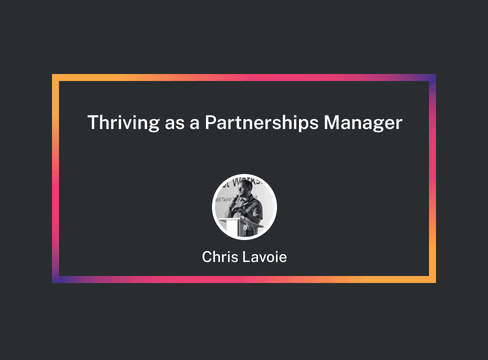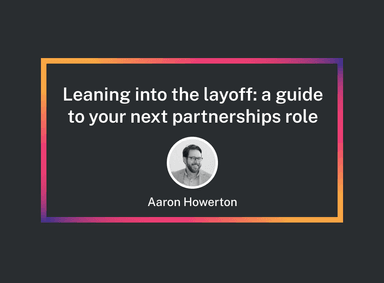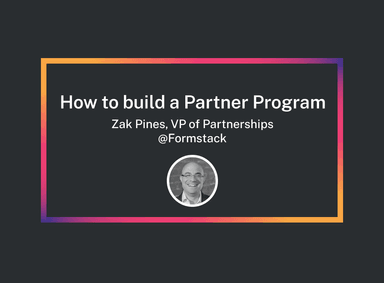Thriving as a Partnerships Manager by Chris Lavoie


Chris Lavoie lives in Toronto and is the Director of Ecosystem Strategy at Digital Bridge Partners, where he supports B2B SaaS companies on ecosystem strategy and training. Before that he spent nearly 3 years at Gorgias mastering the art of managing technology partners and learning to coach others to do it as well. In this article Chris shares some of his lessons that will help you succeed as a Partnerships Manager.
How he started as a Partnerships Manager
I come from an academic background, having completed a PhD in chemistry. Somehow, someway, I ended up in the SaaS industry, working for Gorgias, a leading e-commerce B2B SaaS company that offers customer support for DTC brands. There, I was the first tech partnership hire three years ago and built up their tech partner and integration strategy, helping launch their app marketplace from just a few apps to more than 100.
What was unique about my time at Gorgias was that, in contrast to many other technology partner programs in our space, our goals were exclusively oriented around lead and revenue generation, whereas many tech partner programs owned product-led OKRs (e.g., # of new integrations and integration install growth). It was extremely difficult in the beginning owning a partner-sourced closed ARR goal (I did not get any ramp quota relief), but I came to appreciate it because the pursuit of closing revenue teaches you so many important strategic lessons along the way that can help you succeed when pursuing other goals (e.g., marketing and product-led goals), so I am grateful that our leadership made this the priority from day 1.
Managing Partnerships Managers
9 months into my time at Gorgias I was able to become a manager and eventually build and lead a team of six partnerships managers. Even though I had done a lot of what they were doing, it was still difficult to train them because there were so many different hats they had to wear, and they were so hell-bent on hitting their own quota and generating revenue from partners.
It requires a certain level of maturity and savviness to really understand that what you need to focus on most as a partner manager, is delivering value to partners before you can demand it in return. That’s not obvious when you’re in the pressure cooker as a partnerships manager. So if you just started in that role or are leading a team of partner managers, here are the 5 lessons I learned from my time at Gorgias.
5 lessons to hack the Partnerships Manager role
1- A dedicated Partnerships Manager resource for referrals
Initially, when I was working alone, the process of referring leads to partners was very inefficient and involved a lot of manual work. I had to approach the customer success and sales teams and convince them to sell the partnerships to their clients. Although it was a scrappy process, it worked to some extent because the referrals made the partners happy and ideally the customers too.
When I started leading the team, I realized that referring leads to partners was a full-time job and required a dedicated partner manager. My bold idea to prove this point was to hire a junior partner manager who ran an efficient process of coordinating the outbound referral motion to partners and liaising between customers and the customer success team. This hire proved to be the biggest step-function we were looking for as it allowed us to triple and eventually quadruple the amount of referrals made to partners. We were even able to generate income from rev share agreements with some partners that helped pay for the junior PM’s salary.
2- Prioritizing Partners
I’m not naive in thinking that every company can justify hiring a junior PM to own such a process; it is a gamble that fortunately paid off for us. You can still achieve similar success without a dedicated employee, and to start, you need to consider how many partners your partner managers are managing.
If you have a partner manager who isn’t performing well, take a look at their partner portfolio. Maybe only a few are truly promising and motivated, and have a mature partner program that can reciprocate. In that case, quickly drop the “others” into a non-managed bucket and trim the scope and responsibilities of your PMs. This will free up time that can be used for value delivery. Any PM should be able to manage this process effectively, but as a manager, you need to give them the time and guidance to do so.
My best advice is to refocus the scope of your partner managers. Instead of having them focus 100% on lead-gen driving activities, consider having them spend 70% on standard inbound lead-generating activities and the rest on generating leads for partners. Repurposing your existing PMs in this way can be quite effective, especially until you can justify hiring a PTE like a Jr. PM to own the outbound referral process.
3- Collaborating with Customer Success
Another thing to consider and encourage is collaborating more with customer success. I’m a big fan of having customer success bought into the concept of referring customers to partners. If they’re incentivized to support outbound referral motions, it benefits everyone. The more integrations our customers use, the lower our churn, the better our NPS and overall product stickiness. The key is to literally partner with your success org and help them understand why supporting partnerships (i.e., through referral activities) helps your customers AND helps them (the customer success managers) win. Incentivizing them with spiff obviously will help here as well.
To convince your team about the value of partners, you need data. Most customer success managers don’t know much about specific partners beyond the biggest ones. It’s not their fault nor the expectations, as companies usually don’t educate them about partnerships during onboarding. So introducing the concept of partnerships and prioritizing them requires rewiring their system and literally embedding into their onboarding and overall DNA of the success organization. You need to convince them of the specific value partnerships bring to their customers, so work with RevOps to track the most important partnership-associated metrics (e.g., integration impact on NPS, churn, NRR, etc.)
4- The importance of data
It took a while for us to gather the data we needed to show the importance of sending referrals to partners, but when we finally had access to the data, it was incredibly satisfying. We saw a significant improvement in Net Revenue Retention across all four of our pricing plans as integration adoption grew. For example, if customers used seven integrations or more, Net Revenue Retention was between 110-145% across all pricing plans, which for SMB SaaS (the vertical Gorgias serves), are extremely healthy numbers.
Armed with this data, we could make a strong case to our customer success team leadership to justify increased collaboration with their team. This data got both our CEO and leadership really fired up about partnerships. The key is to prioritize customer value when building partnership strategy and process, and with that, you must understand the data that proves the importance of partnerships. With that, you have everything you need to get cross-functional and leadership buy-in for your biggest bets.
5- Getting Sales onboard
While customer success teammates are the most important stakeholders when it comes to referring customers to partners, I quickly noticed that the sales department was able to send more qualified referrals to partners than the CS team. This makes sense when considering that sales can capitalize on the customer’s interest in purchasing additional software (beyond your own) and ask them if they were evaluating anything else as they are possibly in a rip-and-replace phase with their tech stack. This led to natural conversations where sales could refer customers to partners who offered managed services, help with system integration, loyalty reviews, and marketing apps, etc.
We motivated our sales reps with spiffs and made it agnostic by paying them a fixed amount regardless of which partner they referred a customer to. We also held periodic workshops to train our internal customer success and sales team to support the referral process.
Our approach and messaging in training our sales and success teams was slightly different; we would emphasize to customer success how referrals improved integration adoption and customer health metrics, and stressed to sales how referrals support their own pipeline because partners are motivated to reciprocate referring leads and providing post-deal creation support.
Additional notes:
- You are welcome to connect with Chris on LinkedIn – mention Partnership Leaders in your connect invite
- Chris holds a Partner Manager Mastermind course, exclusive for members of Partnership Leaders. Learn more here.
Join The 1200+ Leaders Transforming Partnerships
As a member of Partnership Leaders you will:
- Build and learn with the top partner people at the best companies around the world.
- Increase your impact and accelerate your career with proven resources, tools, and best practices.
- Grow a network of peers, partners, and advisors with common objectives.


